Kristin Field, one of two 2023 Makers-in-Residence, taught classes in the Maker Lab and created the piece 13 Plants. 13 Plants is on display in the Harold Washington Library Center's State Street window south of the main entrance through November. Her guest blog details the technique and experience of making 13 Plants.
I created these naturally dyed panels over the course of my 12-week residency incorporating the three natural dyeing techniques I taught participants during my library workshops: immersion dyeing, eco printing, and stitched shibori. The natural dyeing process is slow, and I love how each of these pieces reflects all the time that passed as I was making them. From growing the indigo and coreopsis in my backyard, to hours of sewing in parks/during lunch breaks at work/on the CTA, to collecting leaves from the train tracks by my home -- each of these pieces tells the story of the time and place in which they were created. Chicago is embedded in each one.
The panel on the left was hand stitched with over 3,000 stitches which were tightly tied off and the fiber bound before dyeing the piece in indigo, black walnut, and iron. The pattern is a type of shirokage shibori, or “white shadow.”
The middle panel is an ode to my favorite dye flower, Coreopsis tinctoria. The eco prints in the middle of the piece were created with flowers grown in my Chicago backyard. The background of the piece was dyed with coreopsis flowers as well, and I created the coreopsis flower designs with stitched resists.
The panel on the right highlights some of our native trees. First, the piece was eco printed with catalpa, silver maple, ginkgo, eastern redbud, Kentucky coffee, swamp white oak, burr oak, black locust, and honey locust leaves. Then, the background was dyed with black walnut hulls in a design intended to look like dappled sunlight filtered through tree leaves. Finally, I added a bit of my garden to the panel by hammering homegrown indigo leaves throughout the piece. The indigo leaf prints will become bluer over the course of the piece being on display as the fugitive green pigment fades and the blue indigo pigment shows through.
In total, thirteen different plants were utilized in the creation of these three pieces.
Explore natural dyes, inks and stitched shibori with these titles recommended by Field:
Learn more about Maker Lab equipment or check out our upcoming classes.
The Maker-in-Residence is generously funded by the Chicago Public Library Foundation.

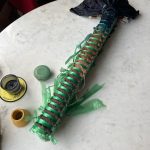
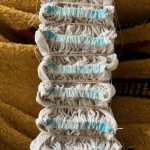
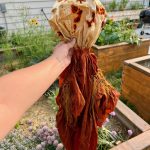
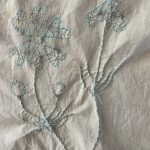

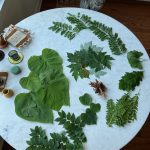
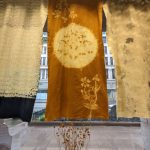



Add a comment to: Guest Blog: 13 Plants by Kristin Field, Maker-in-Residence